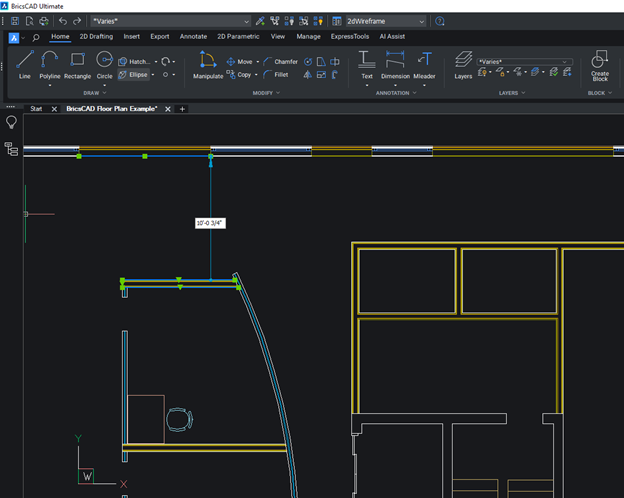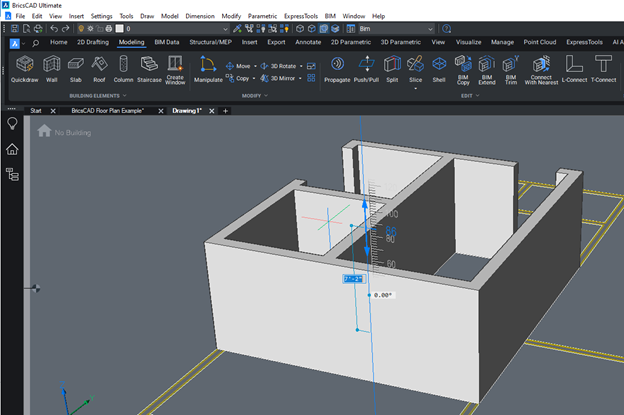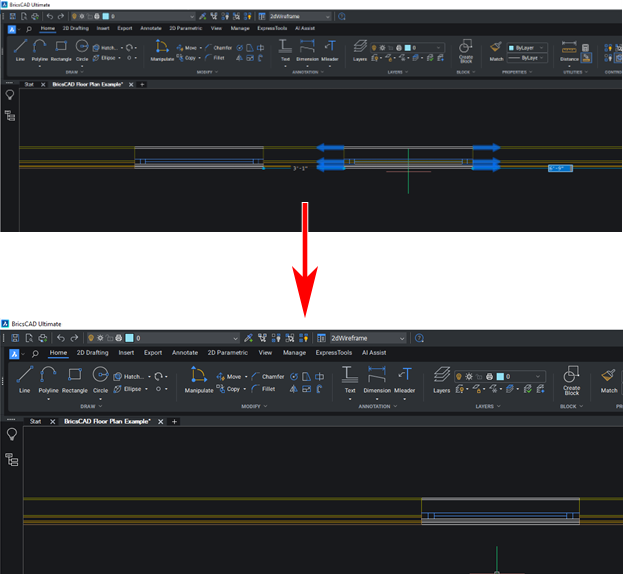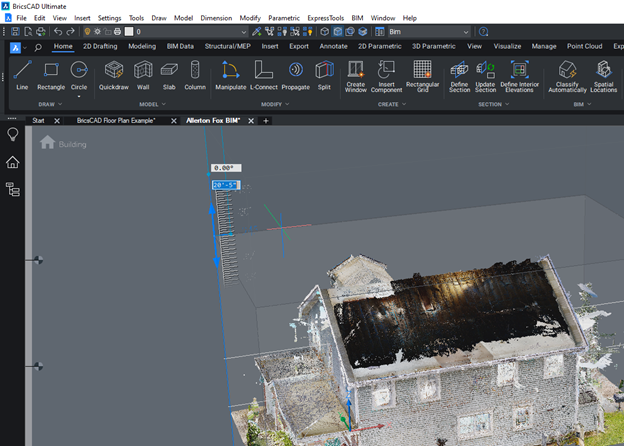Easily Verify Construction Data and Dimensions
Rather than taking days to process RFIs on them, you can simply open the DWG file using BricsCAD Pro and quickly check dimensional data on your own in minutes.
Learn more in this video.
Localized BIM Verification/Creation
Working with 3D/BIM data in BricsCAD BIM is simple for any construction Project Manager to handle with minimal training. Use the files the architect or engineer delivers, and parse them down quickly to show only the data that is relevant to you. Learn more in this video.
Shop Drawings and As-Builts
Having the ability to adjust shop drawings and as-built documentation on the fly can save construction firms time and money. Learn more in this video.
Scanned Data and Point Clouds
BricsCAD simplifies the import of scanned data by reducing the initial import down to manageable, easily identifiable, slices of information so you can tell what’s a wall, versus what’s a window, or a potted plant.
Want to learn more about how BricsCAD can help you? Fill out the form below.
Construction Companies Don’t Need CAD – Or Do They?
 CAD tools have been a mainstay of the design world for decades. They’re how every single plan, model, and design drawing is generated for a construction project, and there’s not an engineering or architectural firm out there that doesn’t have at least a few highly skilled CAD people on staff. The construction world though, has adamantly resisted the siren call of Computer Aided Design because it’s far too complex, requires extensive training, and skilled staff dedicated to doing nothing but 2D/3D modeling. In a construction environment, where it’s hard enough to find and hire people for the actual building work, hiring a CAD person is often a non-starter.
CAD tools have been a mainstay of the design world for decades. They’re how every single plan, model, and design drawing is generated for a construction project, and there’s not an engineering or architectural firm out there that doesn’t have at least a few highly skilled CAD people on staff. The construction world though, has adamantly resisted the siren call of Computer Aided Design because it’s far too complex, requires extensive training, and skilled staff dedicated to doing nothing but 2D/3D modeling. In a construction environment, where it’s hard enough to find and hire people for the actual building work, hiring a CAD person is often a non-starter.
What if you didn’t have to though?
What if CAD, set up correctly, could be easily usable by even your most “technologically challenged” construction super and field staff? That’s what I want to talk about in this article: the tools and areas in BricsCAD Pro, where you can dramatically improve construction information gathering, verification of dimensions, and quickly make shop drawing and as-built adjustments. BricsCAD is a fully-functional 2D/3D CAD system, but it’s been designed to be simple enough for anyone in the construction world to use. You don’t need to have a VDC Manager or CAD Specialist with decades of training to use it effectively.
Most people in the construction world can use BricsCAD Pro to get all the tools they’ll need, at a reasonable cost, and they’re going to use it in four (4) key construction areas:
- Construction Data and Dimension Verification
- Localized BIM Verification/Creation
- Shop Drawings and As-Builts
- Scanned Data and Point Clouds
Construction Data and Dimension Verification
Let’s start with the basic concept of “Construction Data and Dimension Verification”. At the end of the day, no matter how good the design files you get from the architect are, there’s no possible way they can give you all the dimensional data that you need for construction. Yes, they’ll get you room size, column spacing, finish floor datum and a hundred other vital bits of information, but the realities of a construction job are just so complex that there’s always going to be a need to go back into the original DWG and extract data that couldn’t be included in the initial document. For example, once you have the new power transformer specified and sized, will it fit through the proposed door? Is there enough space between the unit and the power supply to meet code? That one door seems to be really close to the intersecting wall – can we fit the 6” casement molding the spec calls for there? There are always going to be these types of questions on a construction job, and you can take days to process RFIs on them, or you can open the DWG file and quickly check dimensional data on your own.
A tool like BricsCAD Pro is ideal for that. It’s lightweight enough that anyone with even a minimal familiarity with other CAD systems can go in and feel comfortable getting base lengths, angles, areas, even volumes from the design file in just a few minutes. Even if you don’t have the actual DWG files, BricsCAD Pro can import PDF files in seconds, and scale them up to real-world size, so you can easily get the dimensional data you need.

Localized BIM Verification/Creation
The second area where construction projects are going to see huge benefits from BricsCAD is when it comes to working with BIM and 3D - what I call “Localized BIM Verification/Creation”. Large BIM systems like Autodesk Revit are overkill for most of us in the construction environment. They’re powerful design tools, meant for use by professional designers with extensive amounts of training. BricsCAD, on the other hand, is a simple CAD system with intuitive BIM modeling built into it. It’s a very simple thing in BricsCAD to take a 2D layout and extrude it up into dimensionally accurate 3D in just a few seconds.
Where it really shines is that you can also do this in a “localized” area, meaning that if all you need to do is make sure your Air Handler isn’t going to hit the ceiling in the warehouse, BricsCAD has you covered. You can model out individual 3D rooms or spaces with BricsCAD in just moments. BricsCAD BIM even has built-in AI functionality to take the 3D walls, ceilings, etc., you generate and automatically tag/label them with the appropriate BIM data types. That 3D info can then be easily exported and shared with your design team in any number of formats, to ensure that changes and revisions are being communicated across the full spectrum of the design/build team. Working with 3D/BIM data in BricsCAD is simple enough for any construction Project Manager to handle with minimal training and it’s an ideal environment for BIM/VDC Managers to work with and verify full design-level BIM files without even needing to convert file types. BricsCAD BIM works with most competitor files directly, can save those out to DWG, and works in native IFC for all its models. BricsCAD BIM will use the files your architect or engineer delivers, and it will also let you parse them down quickly to show only the data and items that are relevant to your work, in just a few minutes.

Shop Drawings and As-Builts
Shop Drawings and As-Builts are next on my list of vital construction areas that BricsCAD is going to save you significant time and money. Shop drawings are a must for any trade contractor in the construction world. It’s great to have an initial design laid out by an engineer, with base functional requirements delineated, but all that must laid out using real world pieces, processes, and equipment. An engineer can design a 7” circular aluminum duct to carry your air flow, but if the manufacturer only delivers in 6” or 8” galvanized steel, there are going to be changes required. You can do this with PDF markup tools or sketching on printed paper documents, but it works best for everyone involved when you can adjust the layout to real-world practice right within the original DWG file. BricsCAD will let you do just that, with native CAD functionality or with one of dozens of partner products for vertical industry design, like civil, mechanical, etc., that will let you put together all your components to actual size and scope automatically.

As-Built documentation is the other side of this BricsCAD functionality. Imagine being able to just open a DWG file and move your door, window, beam, or pipe to the actual installed location, just by moving it over a few feet or inches. What if your CAD system could even remove the original item and patch any holes left in walls, etc. automatically? BricsCAD’s built-in AI tools will do just that, in both 2D and 3D environments, so you can use the same simple tools in any type of design. Oh, and while we’re at it, BricsCAD can easily be structured to give your users palettes filled with tools that carry revision bubbles, callouts, and even standard notes for all this work, so it becomes a simple point-and-click process to identify and label As-Built changes, right in place.
Scanned Data and Point Clouds
The last area I want to discuss in this article is Scanned Data and Point Clouds, not because they’re the least important, but because they’re the ones that scare people the most. Laser scanning, importing point cloud data, and attempting to manipulate it terrifies most construction people. The reason for that fear is simple: the data is immense, takes forever to load, and the editing tools are way too complex, right? In most CAD or reality capture, systems, I’d agree, but not with BricsCAD. This system has been designed to simplify the import of data by reducing the initial import down to manageable, easily identifiable, slices of information so you can tell what’s a wall, versus what’s a window, or a potted plant easily. BricsCAD also reduces the number of points on initial import so that you aren’t bogging down files to a crawl. Plus, the interface is simple enough for anyone to learn and understand in just a few minutes. Best of all, while BricsCAD reduces initial data import for ease of use, it doesn’t delete any data. If you need more exact information in a specific area, you can just draw a box around it and tell BricsCAD what you need. More wall data? More floor slope information? No problem. BricsCAD brings in just the data you need, and only in the area you choose. Going beyond that, BricsCAD and its software partners offer simple, AI-driven processes for converting that scan to 2D floor plans and even fully developed 3D/BIM models automatically. These native “Scan to BIM” processes can have a substantial impact on construction budgets, particularly when dealing with renovation/retrofit projects.

I understand that for construction companies, having a CAD/BIM system for your field staff might seem to be an unwarranted expense. In the modern era of worker shortage and the need to “do more with less”, every advantage is needed to keep us all in the black. A system like BricsCAD, right at the construction staff’s fingertips, can provide remarkable efficiency and cost savings for a really low investment up front. When you couple that with the ease of use and the ability to communicate changes with owners, designers, and all other stakeholders directly on Integrated Project Delivery projects using a tool like BricsCAD, it can even help you to win work. Any way you cut it, in the modern construction arena, a CAD system isn’t optional, it’s a “must have” and for capabilities, ease of use, and affordability, I haven’t seen anything else that compares to BricsCAD.
- James Coppinger
